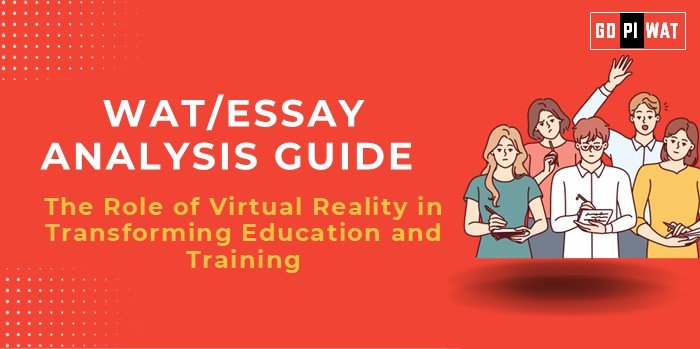📘 Written Ability Test (WAT)/Essay Analysis Guide
🌟 The Role of Virtual Reality in Transforming Education and Training
🎯 Understanding VR’s Importance in Education and Training
With rapid technological advancements, VR is reshaping traditional learning paradigms, merging theoretical knowledge with practical application, and redefining skill acquisition.
📅 Effective Planning and Writing
- Time Allocation:
- Reading & Planning: 5 minutes
- Writing: 20 minutes
- Reviewing: 5 minutes
- Preparation Tips:
- Gather key statistics, global examples, and stakeholder perspectives.
- Map out the structure with focus points for achievements, challenges, and future potential.
📝 Introduction Techniques for Essays
- Contrast Approach: “Despite classrooms evolving from chalkboards to tablets, they still lack immersive interactivity—a gap VR aims to bridge.”
- Solution-Based Approach: “VR is the answer to hands-on training in dangerous industries like aviation and surgery without physical risks.”
- Timeline Approach: “From flight simulators of the 1960s to virtual labs today, VR has steadily transformed education.”
📚 Structuring the Essay Body
- Achievements:
- Discuss retention improvements with VR-based learning showing 75% retention rates.
- Highlight case studies like VR in medical training for surgeries.
- Mention cost reductions in corporate environments for training programs.
- Challenges with Comparative Analysis:
- Highlight costs, infrastructure gaps, and global disparities.
- Compare solutions in developed vs. developing countries.
- Future Outlook:
- Envision greater affordability through innovations.
- Discuss 5G-enabled VR and its potential for smoother experiences.
- Propose integration into standardized curriculums worldwide.
✔️ Concluding Effectively
- Balanced Conclusion: “VR bridges the gap between theoretical and practical learning but requires investments in accessibility to realize its full potential.”
- Global Comparison Conclusion: “While VR transforms education in advanced economies, its adoption in emerging markets will define its global success.”
🔍 Analyzing Successes and Shortcomings
- Key Achievements: Improved engagement, enhanced learning outcomes, and safety in training.
- Ongoing Challenges: High costs, infrastructure limitations, and ethical concerns.
- Global Context: Successful in developed countries, facing hurdles in emerging markets.
🌍 Recommendations for Sustainable Progress
- Encourage public-private partnerships for affordable VR tools.
- Subsidize VR education programs in rural areas.
- Integrate VR training modules into mainstream curricula.
💡 Sample Short Essays on VR in Education
- Balanced Perspective: “Virtual Reality revolutionizes learning with immersive experiences but remains inaccessible to many due to high costs and technological requirements.”
- Solution-Oriented: “To make VR accessible, governments must collaborate with tech firms to subsidize hardware and expand digital infrastructure.”
- Global Comparison: “While countries like the US lead in VR adoption in classrooms, India’s potential remains untapped due to cost and connectivity issues.”


